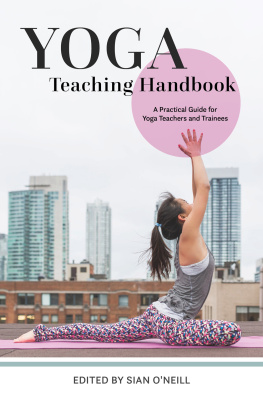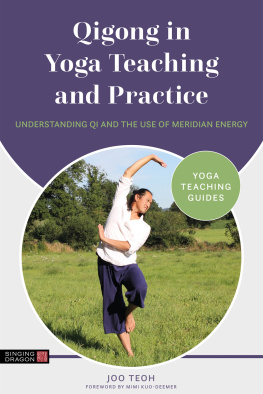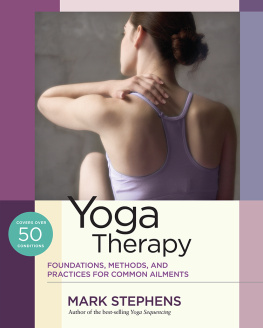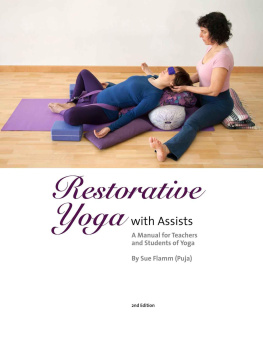Contents

SUPPORTING YOGA
STUDENTS WITH
COMMON INJURIES
AND CONDITIONS
A Handbook for Teachers and Trainees
Dr. Andrew McGonigle, MBBS
Series Editor: Sian ONeill

CONTENTS
PREFACE
I have been studying anatomy in some shape or form for over 20 years. This journey began at Newcastle University where I graduated Medical School in 2005 and then worked for a short time as a foundation doctor. Four years later I had completed my first yoga teacher training course and gained a diploma in holistic massage, and I went back into the dissection laboratory to study fascia with Julian Baker. I soon began to teach anatomy and physiology to yoga teachers and trainees. I quickly realized that a common apprehension amongst yoga teachers is how best to teach those yoga students who are injured or have a medical condition, and I started to run workshops that specifically addressed this topic. A big goal of mine has been to make my teaching accessible, fun, practical, relevant and evidence based, and to reinforce my strong belief that the human body is astonishing and robust.
This handbook aims to give you, as a yoga teacher, the knowledge and confidence you need to be able to approach, advise, support and empower yoga students who have common injuries and conditions so that the practice of yoga is truly accessible for everyone. The wonderful asana illustrations that are featured throughout this handbook are of a diverse group of yoga practitioners and it is my hope that through these illustrations everyone reading this handbook will feel represented in some way, regardless of their ethnicity, gender, age or size.
This handbook includes: relevant sections on the anatomy of the human body; an exploration of some of the main injuries and conditions that affect our population; how to adapt certain asanas so that the practice remains accessible for students affected by these injuries and conditions; practices and exercises which can potentially improve or maintain the health of different regions of the body. The material is covered to a depth that I believe is relevant and accessible for general yoga teachers.
I am indebted to the teachers that I have been fortunate enough to have had over the years: Chris Greathead who first taught me meditation back in 2005; Hamish Henry, Paul Dallaghan and Eileen Gauthier who all taught me Ashtanga yoga and inspired me to continue a daily yoga practice; Kristin Campbell who shifted my perspective and encouraged me to step out of my comfort zone; Anna Ashby, Richard Rosen, Sally Kempton and Jivana Heyman who have all broadened my horizons. I would like to give a special thank you to Sian ONeill for suggesting that I write this handbook in the first place, for being a wonderful editor and for being a constant support throughout the process. Marie Yagami did such a beautiful job creating the asana illustrations and Hank Grebe created some of the wonderful anatomical illustrations that are featured in the handbook. A huge thank you to both of you. Finally, a lot of gratitude goes to my amazing husband Doug who has helped me to remain sane during this process.
INTRODUCTION
Yoga is becoming more and more popular each year. A joint study by Yoga Journal and Yoga Alliance (2016) found that the number of American yoga practitioners had increased to over 36 million in 2016, up from 20 million in 2012. The study also found that there had been a huge increase in the number of practitioners who are 50 years old and over, and that three-quarters of practitioners also engage in exercise including running, group sports, weightlifting and cycling. Many healthcare professionals are recognizing the potential benefits of yoga and are referring their clients and patients in order to support injury rehabilitation and/or the management of certain medical conditions. All of these factors result not only in busier yoga classes but also in a much greater likelihood that the students will be presenting to class with pre-existing injuries and/or medical conditions. This puts a greater demand on the yoga teacher and adds to the important challenge of creating an inclusive and accessible space.
Whats the difference between an injury and a medical condition?
The term load describes physical stresses acting on the body or on anatomical structures within the body, and these stresses include motion and force. An injury essentially occurs when the load applied to a region of the body exceeds that regions ability to withstand such a load. This leads to deformation of tissues beyond their failure limits, which results in damage of anatomical structures or alteration in their function. This will also involve an inflammatory response by the body to initiate healing. The magnitude of the inflammatory response depends on the severity of the injury and the degree of blood vessel formation in the tissue that is injured (Smith et al. 2008).
A medical condition is a broad term that includes all diseases, disorders or non-pathologic conditions that normally receive medical treatment (such as pregnancy or childbirth). The term medical condition generally includes mental illnesses.
The prevalence of yoga-related injuries
There has been a lot of discussion in the media over the past few years about the potential risks associated with practicing yoga, although most of this seems to be based on anecdotal evidence. However, there have been a few studies that have investigated this topic more thoroughly.
In a study by Bueno et al. (2018) the authors reported that the injury prevalence of yoga was less than 1% when compared to 38% among soccer players, 19% among runners and 9% among subjects participating in strength training. In a national cross-sectional survey in Germany by Cramer et al. (2019) an average of 0.60 injuries per 1000 hours of yoga practice was reported. Based on this, the authors stated that yoga appears to be as safe or safer when compared to other exercise types. They commented that adverse events were more common in participants with a pre-existing medical condition and among participants who did yoga on their own without prior or current supervision by a teacher. In a study by Wiese et al. (2019) the authors stated that the number of injuries reported by yoga participants per years of practice exposure was low and the occurrence of serious injuries in yoga was infrequent compared to other physical activities, suggesting that yoga is not a high-risk physical activity. A systematic review and meta-analysis of literature by Cramer et al. (2015) suggested that yoga is as safe as other forms of physical activity.
Preventing injury
As we have just discussed, all physical activity brings with it the risk of injury, and yoga is no exception. The practice of ahimsa (non-violence) as part of the yogic philosophy no doubt complicates things here for yoga teachers who can often feel responsible for constantly protecting their students against injury.
There are a couple of practical things that we could do as yoga teachers to reduce the risk of a student getting injured: we could avoid applying force if we are offering adjustments and instead use touch to simply bring awareness to a certain area of the body or as a directional cue; we could offer a student who has osteoporosis the support of a chair or a wall during a balance pose to reduce their risk of falling. Continuing to encourage our students to cultivate body awareness is also significant here. This involves an attentional focus on and awareness of body position (proprioception) and internal body sensations (interoception). By focusing on controlled, breath-led movement that is in a pain-free range we may be able to decrease the incidence of injuries in our classes.










